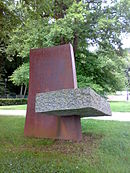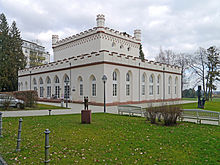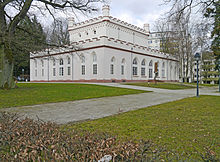Gothic house (Bad Homburg)
The Gothic House on the outskirts of Bad Homburg , in the Dornholzhausen district , is a former hunting lodge that has housed the city's cultural and historical museum since 1985.
history
Landgravine Elisabeth left the Gothic House for her husband, Landgrave Friedrich VI, from 1823 . build in neo-Gothic style. The foundation stone was built into the foundation on April 17, 1823. The hunting lodge is located at the end of the Tannenwaldallee, which creates a direct connection between the Bad Homburg Palace and the Gothic House and was part of the landgrave's gardens .
Elisabeth, whose dowry made the building possible, planned it as a representative location for the Landgrave's celebrations and excursions. It is not known who made the design. Friedrich Lotz suspects the architect Jeffry Wyatville - creator of the extension of Windsor Castle . The construction management was the responsibility of Georg Moller . On November 9th, 1823 a scaffold overturned and buried eight workers under it. All were injured, one died as a result of the accident. The Landgravine then stopped the construction work.
The Gothic House became the property of the landgrave's forest administration in 1860, which only used some of the rooms, the others were available for viewing and renting. This did not change after 1866, when Hessen-Homburg became Prussian as a result of the war of 1866 . However, part of the building was reserved for use by the Prussian royal court.
Kaiser Wilhelm II wanted to have the "monument protection secured in the land register" when it was sold to an innkeeper; why this did not happen is unclear. In 1929 the new owner had the house converted into a hotel with a restaurant and café by adding a false ceiling and making other structural changes. The hunting lodge was a popular place for excursions and recreation among the people of Bad Homburg and was connected to the Bad Homburg tram network from 1899 to 1923 .
After the Second World War the slow decline of the house began due to several changes of ownership. For many old Homburgers, the establishment of the “Ponderosa Saloon” disco was the final low point.
In 1968 the land was sold by the current owner, the Obertaunuskreis, to the Frankfurt real estate speculator Jan Lipinski and the building seemed to be irredeemably lost. In addition, two seven-story high - rise buildings were built right next to the Gothic House. The "staff apartments" for a planned hotel are two building sins that still do not fit into the townscape and landscape.
In 1977 the Gothic House was literally entered in the monument book “at the last minute” . In 1980, after Lipinski went bankrupt, the property became the property of a property management company in Frankfurt.
After a fire on December 9, 1980, the hunting lodge was completely restored in 1981. Since 1985 it has housed the city's cultural history museum with changing special exhibitions . The museum has permanent sections on the history of the city and the Landgraviate of Hessen-Homburg, on art, fashion and headgear (“hat museum”) as well as a coin cabinet and a café. The focus of the hat exhibition is the well-known " Homburg ". From 1985 to June 2017, the Bad Homburg city archive was also located in the Gothic House. “The memory of the city of Homburg” moved to the Villa Wertheimber in Gustavsgarten in summer 2017 .
The Gothic House is now a cultural monument under the Hessian Monument Protection Act .
Historical city museum
Here the history of the landgraves, the city and the bathing and health resort is shown. The museum was founded in 1916 as the “City History Museum”, but it was not until 1985 that it moved to its current location in the Gothic House.
Romantic room
In the Romantic rooms are exhibited since 2012 furniture and furnishings from the 18th and 19th centuries.
Hat museum
The hat museum is a Homburger specialty, which due to the historical importance of the hat industry for the city in general and its worldwide fame due to a special hat model, the "Homburg" , initiated by the Prince of Wales and manufactured in the Homburg hat factory Möckel from the 1880s Men's hat.
Sculpture garden
The garden around the Gothic House is a sculpture garden with several large sculptures . To be shown:
| image | Artist | title | year | annotation |
|---|---|---|---|---|
 |
Hans Steinbrenner | "Figure" | 2005 | |
 |
Hartmut Stielow | "Untitled" | 1997 | Part of the first Blickachsen exhibition |
 |
Bruce Beasley | "Spokesman II" | 1994 | Sculpture welded from bronze in 1994 by Bruce Beasley (born 1936 in Los Angeles, USA). The sculpture was part of the second Blickachsen exhibition in 1999. Then it stood on Ferdinandsplatz in Bad Homburg. It is now on display in front of the south side of the Gothic House, in its sculpture garden. |
 |
Isolde Schmitt-Menzel | mouse | 2013 | Bronze sculpture |
 |
Kenny Hunter | Red boy | 2007 | Red Boy by Kenny Hunter comes from the exhibition "Blickachsen 6" (2007), where it was a crowd puller and was subsequently acquired by the city of Bad Homburg. During the exhibition, this little boy stood in front of the Kaiser Wilhelms Bad - opposite the larger than life, powerful Kaiser Wilhelm. The work of art was specially made for this location. After the exhibition ended, however, it could not stay there and was added to the sculpture avenue.
At the end of April 2017, the bronze statue at the train station was dismantled and then placed at the Gothic House. |
In the neighborhood
The horse grave is located about 100 meters north of the Gothic House. Landgrave Friedrich V valued his favorite horse “Madjar” so much that in 1773 he literally had it buried. The horse grave was decorated with a bronze plaque showing a poem written by the landgrave himself:
“The most beautiful horse is buried here,
which unites all virtues.
If one could have friendship with animals,
my friend would be here. "
A gravel path forms a visual axis from the Gothic House to the Elisabethenschneise, which leads to the Hirschgarten . A copy of the Landgrave Column was erected along this path in 2011. The original of this column stood from 1816 to 1835 near its current location. The original has been in Homburg Castle since 1835. The column commemorates Landgrave Friedrich V.
"To the
most transparent gentleman Landgrave
Friedrich Ludwig zu Hessen Homburg
on January 30th 1816 at
the beginning of his 69th life, and
51st year of reign
of his loyal subjects"
literature
- Friedrich Lotz: History of the city of Bad Homburg before the height. Volume 2: The Landgrave Period. Kramer, Frankfurt am Main 1972, ISBN 3-7829-0133-9 , pp. 246-247.
- Gerta Walsh: The Gothic House was rebuilt like Phoenix from the ashes. In: Taunus-Kurier. March 2, 1985, p. 15.
- Beate Datzkow: The Gothic House in the Great Fir Forest in Bad Homburg in front of the height. (From the city archive. Lectures on Bad Homburg's history, special volume). Bad Homburg vdHöhe 2005, ISBN 3-928325-38-8 .
Web links
- State Office for Monument Preservation Hesse (ed.): Gothic House In: DenkXweb, online edition of cultural monuments in Hesse
Individual evidence
- ^ Johann Georg Hamel: Historical fragments from Homburg's prehistory. Vol. II., P. 69.
- ↑ Stella Junker-Mielke, Gerta Walsh: Garden landscape in Bad Homburg vd Höhe: The Landgrave Gardens Development History and Garden Art Evaluation, City of Bad Homburg (2001), p. 74, ISBN 3928325302
- ↑ Archived copy ( memento of the original dated November 2, 2017 in the Internet Archive ) Info: The archive link was inserted automatically and has not yet been checked. Please check the original and archive link according to the instructions and then remove this notice.
- ↑ http://www.bad-homburg.de/stadtarchiv
- ↑ http://www.badhomburg.de/microsite/museum-gotisches-haus/portrait/Geschichte_Museum.php
- ↑ http://www.badhomburg.de/microsite/museum-gotisches-haus/museum_ausstellungen/Hutmuseum.php
- ^ Fried Lübbecke: Small Fatherland. Homburg vor der Höhe. Kramer, Frankfurt am Main 1956, p. 16.
- ↑ The horse grave is being pimped up. In: Taunus Zeitung. April 5, 2011, p. 19.
Coordinates: 50 ° 14 ′ 3 ″ N , 8 ° 34 ′ 29 ″ E

















